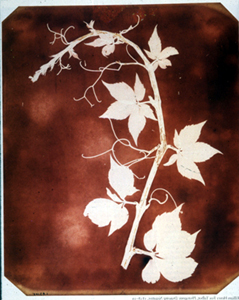Discovery
of the PHOTOGRAM
The photogram is as old as photography itself, perhaps older.
On object laid
on a grass lawn will leave a photosensitive image after a few days
and this is no different to the images made by photograms. I have
used this method to make photosynthetic images on the leaves of Bromeliad
plants. Archimedes 287? bc 212 first noted aspects of the pigmentation
change in plant tissue due to exposure to sunlight and since then
photosynthesis has been central to much speculative and scientific
investigation.
While not a recommended method of making images, sun burn marks on
our bodies are similar.
When photography
as we know it was invented, (1839 was the official date) many of the
first inventors used objects like the leaves of plants and fine lace
laid on the photosensitized material to form their images. These first
photo-emulsions were very slow and needed great amounts of light to
form an image; they might have to be exposed to sunlight for 10mins
or more. Fox Talbot,
and Hippolite
Bayard both used this technique (photograms) in their experiments.
Later in the early 1840s, Anna
Atkins used this technique to produce a wonderful series of botanical
works that were to form the basis for the first photographic book
through a contact process called the cyanotype.
The following is an extract
from Fox Talbot's "Pencil of Nature".

Fox Talbot Cir
1830s
Hitherto we have presented to the reader the representations of distant
objects, obtained by the use of a Camera
Obscura. But the present plate represents an object of this natural
size. And this is effected by quite a different and much simpler process,
as follows.
A leaf of a plant, or any
similar object which is thin and delicate, is laid flat upon a sheet
of prepared paper which is moderately sensitive. It is then covered
with a glass, which is pressed down tight upon it by means of screws.
This is done, it is placed
in the sunshine for a few minutes, until the exposed parts of the
paper have turned dark brown or nearly black. It is then removed into
a shady place, and when the leaf is taken up, it is found to have
left its impression picture on the paper. This image is of a pale
brown tint if the leaf is semitransparent, or it is quite white if
the leaf is opaque.
The leaves of plants thus
represented in white upon a dark background, make very pleasing pictures,
and I shall probably introduce a few specimens of them in the sequel
to this work ; but the present plate shows one pictured in the contrary
manner, viz. dark upon a white ground; or, speaking in the language
of photography, it is a positive and not a negative image of it. The
change is accomplished by simply repeating the first process. For,
that process, as above described, gives a white image on a darkened
sheet of paper ; this sheet is then taken and washed with a fixing
liquid to destroy the sensibility of the paper and fix the image on
it.
This done, the
paper is dried, and then it is laid upon a second sheet of sensitive
paper, being pressed into close contact with it, and placed in the
sunshine : this second process is evidently only a repetition of the
first. When finished, the second paper is found to have received an
image of a contrary kind to the first ; the ground being white and
the image upon it dark.